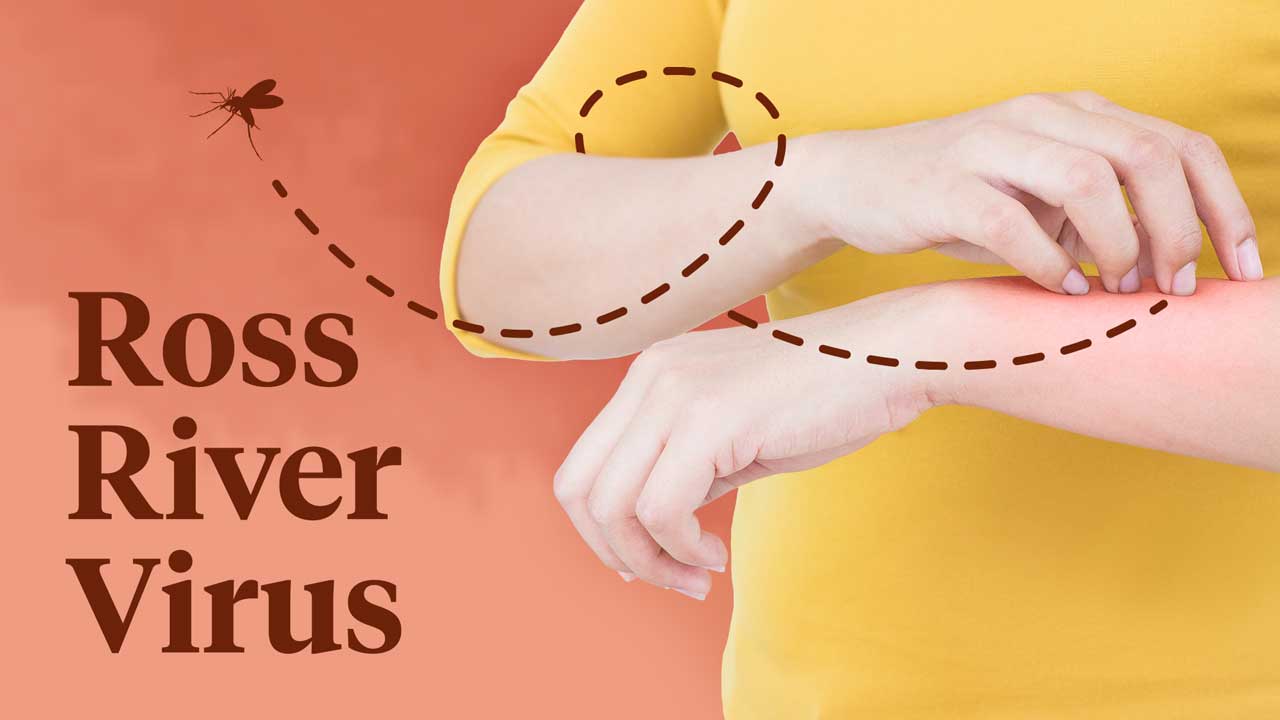Ross River virus infection is Australia's most common mosquito-borne infection (Healthdirect 2023).
What is Ross River Virus Infection?
Ross River virus (RRV) infection, also known as Ross River fever or epidemic polyarthritis, is endemic in Australia, Papua New Guinea, parts of Indonesia, and several islands in the South Pacific (NT.GOV.AU 2023).
The largest outbreak in Australia occurred in 2015, with over 9,000 cases notified, more than 6,000 of them from Queensland (DoHaAC 2023). Such epidemics relate to favorable mosquito breeding conditions such as heavy rainfall, floods, high tides, and high temperatures (Murphy et al. 2020).
Since 2015, there have been at least 2,000 cases of RRV infection in Australia every year, with most occurring in Queensland (DoHaAC 2023).
Of the more than 40 species of mosquito (Queensland Health 2017) that have been found to be capable of carrying the virus, the most significant are:
- Culex annulirostris (common banded mosquito; breeds in permanent bodies of fresh water)
- Ochlerotatus vigilax (salt marsh mosquito of northern Australia; breeds in salty pools in mangroves and salt marshes after flooding by spring tides and heavy rains; aggressive biter during the day and night)
- Ochlerotatus camptorhynchus (southern Australian salt marsh mosquito)
- Aedes notoscriptus (backyard mosquito; breeds in containers close to homes and other human activity)
- Ochlerotatus normanensis (flood water mosquito; breeds in temporary ground pools in drier areas of northern Australia).
(NT.GOV.AU 2023; Wildlife Health Australia 2015)

Transmission of Ross River Virus
Mosquitoes are believed to pick up RRV from kangaroos, wallabies, possums, wombats, wild rodents, birds, flying foxes, dogs, horses, cattle, and possibly humans (Murphy et al. 2020; Skinner et al. 2019). The virus enters the bloodstream through saliva from an infected mosquito, reproduces in red cells, and then in muscles, joints, and skin (ABC Health 2015).
RRV cannot be directly spread from person to person (Healthdirect 2023).
Symptoms of Ross River Virus Infection
Many of those bitten by an infected mosquito do not develop any symptoms. This is especially true of children, who generally only experience mild symptoms that last for a shorter length of time, if any (NT.GOV.AU 2023).
Most cases are in adults aged 30 to 64 years (Murphy et al. 2020). The incubation period is usually 7 to 14 days, but symptoms can develop anywhere between 3 and 21 days after being bitten (NT.GOV.AU 2023).
The first symptoms of RRV infection are typically severe pain in multiple joints (usually the wrists, knees, ankles, and fingers) and stiffness (NT.GOV.AU 2023; NSW Health 2022).
Other symptoms may include:
- Fatigue and lethargy
- Flu-like symptoms (fever, chills, headache, and pain in muscles, ligaments, tendons, and surrounding joints)
- Raised, red rash on limbs and trunk that generally disappears within one to two weeks
- Nausea
- Swollen lymph nodes
- Sore eyes and throat
- Tingling on soles of feet and palms.
(NT.GOV.AU 2023; NSW Health 2022)
Symptoms usually resolve within six weeks, but in some cases, they may last for months or even up to one or two years. In about 10% of cases, people will experience ongoing depression and fatigue (SA Health 2022). In most cases, getting RRV once should guarantee lifelong immunity, although there have been a few instances of reinfection (NT.GOV.AU 2023).
Diagnosing Ross River Virus Infection
RRV infection is diagnosed via blood tests to detect antibodies. Typically, there will be one blood test undertaken when the patient is unwell and another two weeks later. This will allow the two test results to be compared (Healthdirect 2023).
It may be necessary to eliminate other causes of similar symptoms, such as dengue, Barmah Forest virus, chikungunya, rubella, influenza, and rheumatoid arthritis (Farmer & Suhrbier 2019).
Treating Ross River Virus Infection
Treatment is non-specific. Anti-inflammatories such as ibuprofen, paracetamol, and aspirin (not for children under the age of 12) may provide effective relief of symptoms (Healthdirect 2023; NT.GOV.AU 2023).
A combination of rest, exercise, and a healthy diet is also important (Healthdirect 2023). Stress, fatigue, and alcohol can exacerbate symptoms (NT.GOV.AU 2023).
Preventing Ross River Virus Infection
Protect yourself from mosquito bites by:
- Avoiding periods of heavy infestation (early evenings and dawn in warmer months)
- Using insect repellent
- Wearing protective clothing in light colors
- Screening living and sleeping areas
- Removing potential mosquito breeding areas (uncovered, still water containers).
(Queensland Government 2017)
Topics
References
- ABC Health 2015, Ross River Fever, ABC Health, viewed 12 December 2023, http://www.abc.net.au/health/library/stories/2006/01/19/1831791.htm
- Department of Health and Aged Care 2023, National Communicable Diseases Surveillance Dashboard, Australian Government, viewed 12 December 2023, https://nindss.health.gov.au/pbi-dashboard/
- Farmer, JF & Suhrbier, A 2019, ‘Interpreting Paired Serology For Ross River Virus And Barmah Forest Virus Diseases’, Australian Journal of General Practice, vol. 48, no. 9, viewed 14 December 2023, https://www1.racgp.org.au/ajgp/2019/september/paired-serology-for-ross-river-virus-and-barmah-fo
- Healthdirect 2023, Ross River Virus Infection, Australian Government, viewed 11 December 2023, https://www.healthdirect.gov.au/ross-river-virus
- Murphy, A K 2020, ‘Spatial and Temporal Patterns of Ross River Virus in South East Queensland, Australia: Identification of Hot Spots at the Rural-urban Interface’, BMC Infectious Diseases, vol. 20, no. 722, viewed 12 December 2023, https://bmcinfectdis.biomedcentral.com/articles/10.1186/s12879-020-05411-x
- NT.GOV.AU 2023, Ross River Virus, Northern Territory Government, viewed 11 December 2023, https://nt.gov.au/wellbeing/health-conditions-treatments/viral/ross-river-virus
- Queensland Government 2017, Ross River Virus, Queensland Government, viewed 14 December 2023, https://www.qld.gov.au/health/condition/infections-and-parasites/viral-infections/ross-river-virus
- Queensland Health 2017, Ross River Virus Infection, Queensland Government, viewed 11 December 2023, https://www.health.qld.gov.au/cdcg/index/ross-river-virus-infection
- SA Health 2022, Ross River Virus Infection - Including Symptoms, Treatment and Prevention, Government of South Australia, viewed 14 December 2023, https://www.sahealth.sa.gov.au/wps/wcm/connect/public+content/sa+health+internet/conditions/infectious+diseases/ross+river+virus+infection/ross+river+virus+infection+-+including+symptoms+treatment+and+prevention
- Skinner, E, Webb, C & Flies, E J 2019, ‘How Australian Wildlife Spread and Suppress Ross River Virus’, The Conversation, 15 January, viewed 12 December 2023, https://theconversation.com/how-australian-wildlife-spread-and-suppress-ross-river-virus-107267
- Wildlife Health Australia 2015, Ross River Virus in Australian Wildlife, Wildlife Health Australia, viewed 11 December 2023, https://wildlifehealthaustralia.com.au/Portals/0/ResourceCentre/FactSheets/Mammals/Ross_River_Virus_and_Australian_Wildlife.pdf
 New
New 
